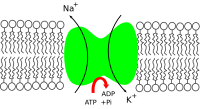
Photo from wikipedia
D ata from laboratory animal experiments, observational epidemiological studies, and randomized controlled trials provide strong evidence for a causal relationship between dietary sodium intake and blood pressure [1]. However, the… Click to show full abstract
D ata from laboratory animal experiments, observational epidemiological studies, and randomized controlled trials provide strong evidence for a causal relationship between dietary sodium intake and blood pressure [1]. However, the association between sodium intake and clinical cardiovascular disease (CVD) remains conflicted: some studies have found a positive linear association between dietary sodium intake and risk of CVD [2–4]; others have reported a J or U-shaped association between dietary sodium and CVD [5–7]. Methodologic limitations, including inconsistencies in dietary sodium measurement methods, confounding factors, and reverse causality, are likely to blame for these conflicting findings [8]. If conducted properly, 24-h urinary sodium excretion is considered the most accurate method of estimating dietary sodium intake at the individual level [8]. It is estimated that approximately 90% of consumed sodium is absorbed and excreted in the urine, and the correlation between measured dietary sodium intake and urinary sodium excretion is more than 0.75 [8,9]. To estimate an individual’s usual dietary intake, multiple 24-h urinary measurements of sodium are required because of large day-to-day variation in dietary intake [10,11]. However, collection of 24-h urine specimens is burdensome and challenging in free-living populations. Thus, overnight urine collection and spot urine collection have been used as alternative methods to estimate dietary sodium intake. In general, overnight (usually 8 h) urinary sodium excretion is well correlated with 24-h urinary sodium excretion [12,13]. However, because of larger observed intra and interindividual variations in overnight sodium excretion, more numbers of overnight sample collections are required to achieve the same precision as 24-h sample collections in estimating the association between an
Journal Title: Journal of Hypertension
Year Published: 2017
Link to full text (if available)
Share on Social Media: Sign Up to like & get
recommendations!